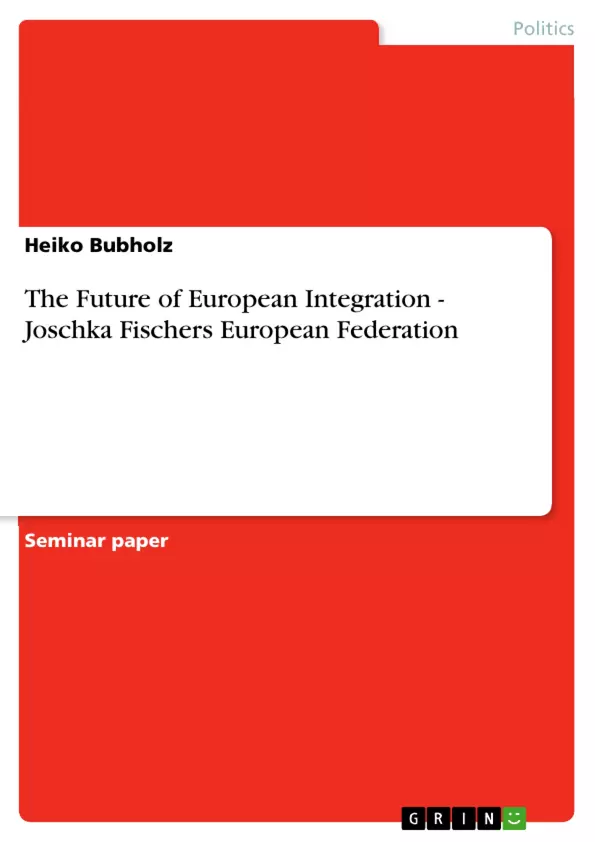Now, in January 2002, a visible step in European integration has been accomplished. With the introduction of the European €-currency about 296,8 millions citizen1 of the European Union will hold the new symbols of the unity of Europe’s peoples in their hands. What began with an attempt of reconciliation and co-operation via the ECSC in 1952 has now developed towards a so far unprecedented transfer of sovereign rights and competencies from nation-states to a supranational/intergovernmental organisation.
Helmut Kohl, former chancellor of Germany and one of the initiators of the European currency, ascertains that the process of integration thus became irreversible. Though currently limited to a number of Member States of the EU, the “European experiment” attained a new dimension. Spectators, – in the words of Kohl – passing the streets and places of Kraków, Prague or Budapest, may notice and experience there the European spirit as well. Hence, Europe shall not be limited in its today’s proportions. The historical and moral – as well as rational – obligation of the EU therefor has to be the accession of the Candidate Countries in the earliest possible occasion2.
This, however, implies the Union’s ability – and will – to cope with its own process of deepening and widening. During the IGC of Nice, European statesmen tried to negotiate a somehow reformed structure able to adopt an enlarged Union. Though not ratified yet, the Treaty of Nice will provide the future EU with means in the spirit of Maastricht and Amsterdam. Yet, Jacques Delors himself declared that the treaty establishing the European Union would for sure not become a part of fine literature. Drafted by lawyers it is, according to Delors, hard to understand without a manual3. This makes the problems evident, which the European idea is faced today. Though proclaimed to be a revolutionary step forward, the amendments of the Nice Treaty in effect do only barely “continue the process of creating an ever closer union among the peoples of Europe”4.
[...]
______
1 Bundesverband deutscher Banken (2001), p. 12-13.
2 Kohl (2001).
3 Delors (1993), p. 4: „Zweifellos wird dieser Vertrag [Vertrag von Maastricht] nicht in die Literaturgeschichte eingehen. Ohne genaue Gebrauchsanweisung ist er schwer zu verstehen. Er ist das Ergebnis vielfacher Kompromisse und von Juristen geschrieben“.
4 Preamble of the Treaty on the European Union.
Inhaltsverzeichnis (Table of Contents)
- Introduction
- State of Affairs
- The European State
- The European Federation
- The Theory
- The Application
- The European Government and Parliament
- The Legislative Branch
- The Executive Branch
- The European Constitution
- The Theory
- The Application
- The Principle of Subsidiarity
- The European Federation
- From Staatenverbund to European Federation
- Constraints of the Federalisation of Europe
- Conclusion
Zielsetzung und Themenschwerpunkte (Objectives and Key Themes)
This paper aims to analyze the concept of a European Federation, specifically focusing on the ideas of Joschka Fischer, a prominent figure in European integration. The paper examines the theoretical and practical implications of this concept within the context of the evolving European Union.
- The theoretical underpinnings of a European Federation
- The practical implications of establishing a European Federation
- The role of the European Parliament and Government in a federal European structure
- The development of a European Constitution
- The challenges and constraints facing the federalization of Europe
Zusammenfassung der Kapitel (Chapter Summaries)
- Introduction: The chapter highlights the significance of the introduction of the Euro currency as a landmark event in European integration, emphasizing the transfer of sovereign powers from nation-states to a supranational organization. It also underscores the need for the EU to expand and deepen its integration while addressing the complexities of the process.
- State of Affairs: This chapter examines the current state of affairs in European integration, exploring the challenges and opportunities associated with the evolving Union. It analyzes the role of the Treaty of Nice in shaping the future of the EU.
- The European State: This chapter delves into the concept of a European state, focusing on the theory and application of a European Federation. It explores the potential structure and functions of a European government and parliament within a federal framework.
- From Staatenverbund to European Federation: This chapter examines the historical trajectory of European integration, tracing the path from a loose association of states towards the potential creation of a European Federation.
- Constraints of the Federalisation of Europe: This chapter analyzes the various constraints and challenges facing the process of European federalization. It identifies potential obstacles to the implementation of a federal structure, such as national sovereignty and political resistance.
Schlüsselwörter (Keywords)
This paper focuses on the key concepts of European integration, European Federation, supranationalism, intergovernmentalism, European Union, Treaty of Nice, European Constitution, federalism, sovereignty, and the role of national states in a potential European Federation.
- Quote paper
- Heiko Bubholz (Author), 2002, The Future of European Integration - Joschka Fischers European Federation, Munich, GRIN Verlag, https://www.grin.com/document/5545



